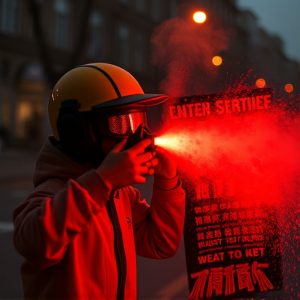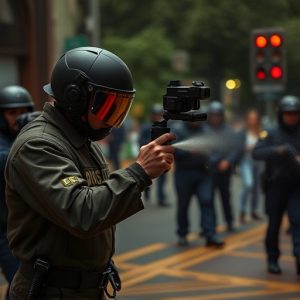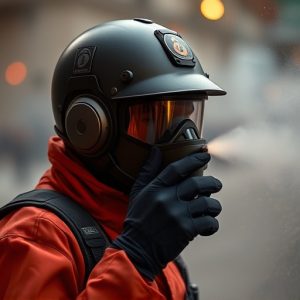Decoding Spray Distance: The Science of Pepper Spray and Self-Defense Safety
Pepper spray is an effective non-lethal self-defense tool containing Oleoresin Capsicum, which temp…….
Pepper spray is an effective non-lethal self-defense tool containing Oleoresin Capsicum, which temporarily incapacitates attackers by causing intense irritation to their eyes, respiratory system, and skin. The spray's range typically falls between 4 to 12 feet, allowing users to maintain a safe distance. It's crucial to consider environmental factors such as wind, which can impact the spray's trajectory, making practice essential for accurate deployment. Contrary to causing permanent blindness, pepper spray induces a form of temporary blindness by triggering severe eye irritation and involuntary eyelid closure, giving users a critical moment to escape or find help. Understanding its effects on vision is important not only for personal safety but also for navigating legal considerations surrounding its use. Mastery of pepper spray's range and proper handling can prevent self-injury or harm to bystanders, ensuring it remains a valuable component in self-defense strategies. The question "Can pepper spray blind you?" is accurately answered with a temporary blindness due to the overwhelming irritation it causes, emphasizing the necessity of using this tool responsibly and within legal boundaries. Users should familiarize themselves with both the practical application and legal restrictions on pepper spray, which vary by jurisdiction, to ensure safe and effective use for self-defense.
When considering personal safety, understanding the capabilities of self-defense tools like pepper spray is paramount. This article delves into the critical aspect of spray distance, a factor that significantly influences the efficacy of pepper spray as a defensive measure. We explore the scientific principles at play, addressing the question “Can pepper spray blind you?” and its impact on vision. By examining the mechanics of pepper spray, we provide clarity on its visual disabling effects and discuss the necessary safety precautions and legal considerations to ensure responsible use. Join us as we navigate the science behind this potent self-defense tool and its role in protecting one’s well-being.
Understanding Spray Distance and Its Impact on Self-Defense
When it comes to self-defense products, understanding the spray distance of a defensive spray like pepper spray is crucial for its effective use. Pepper spray, also known as OC (Oleoresin Capsicum) spray, is designed to incapacitate an assailant by causing intense irritation to the eyes, respiratory system, and skin. The spray distance directly impacts the efficacy of the product, as it determines the range within which the active ingredients can reach and affect an attacker. Typically, high-quality pepper sprays have a spray distance that ranges from 4 to 12 feet, allowing for a safe distance between the user and the threat. It’s important to note that environmental factors such as wind direction and speed can influence the trajectory of the spray, which is why practicing with your self-defense spray is essential. Understanding how far the spray can reach not only helps in anticipating the attacker’s approach but also ensures that you maintain a safe distance while deploying the spray. In terms of personal safety, can pepper spray blind you? While it may not cause permanent blindness, the intense burning sensation and temporary loss of vision caused by the spray can provide sufficient time to escape or seek help. The impact of pepper spray on an attacker is immediate and overwhelming, often leading to a quick end to the confrontation, thus highlighting the importance of considering the spray distance when choosing a self-defense weapon. Properly understanding and utilizing this aspect of pepper spray can significantly enhance one’s personal safety strategy.
The Science Behind Pepper Spray and Visual Disability
Chemical agents like pepper spray are formulated with capsaicinoids, which are responsible for inducing intense irritation upon contact with mucous membranes and skin. The effects of pepper spray can temporarily incapacitate an individual by causing pain, coughing, and severe tearing in the eyes. While it is a non-lethal self-defense tool commonly used by law enforcement and civilians alike, understanding its impact on vision is crucial. Pepper spray’s irritant properties can lead to temporary blindness, not because it damages the eyes structurally but due to the sensation of intense pain causing involuntary closure of the eyelids. This protective reflex prevents light from entering the eyes and effectively renders an individual visually impaired for a few minutes until the effects subside. The discomfort and disorientation caused by pepper spray can significantly hinder an assailant’s ability to see clearly, thus providing a defense mechanism. Additionally, the impact of the spray on visual function varies depending on factors such as wind conditions, distance between the user and target, and the concentration of the spray. Users must be trained in its proper use to ensure safety and effectiveness, as incorrect application could potentially result in unintended consequences, including accidental injury to oneself or bystanders. Understanding the science behind how pepper spray affects vision is essential for both personal defense strategies and legal considerations regarding its use.
Can Pepper Spray Cause Temporary Blindness? Safety Precautions and Legal Considerations
Pepper spray is a non-lethal self-defense tool widely used for personal safety, designed to temporarily incapacitate an assailant by causing intense irritation to the eyes and mucous membranes. Often referred to as OC (Oleoresin Capsicum) spray, it can indeed cause temporary blindness. The effects are a result of the capsaicin in the spray, which targets the trigeminal nerves in the face, leading to an uncontrollable spastic response that renders the attacker disoriented and unable to see for a period, usually lasting from 15 to 45 minutes. It’s crucial to understand the implications of using such a tool, both for personal safety and for legal reasons. When considering the use of pepper spray as a deterrent, one must weigh its effectiveness against potential overuse or misuse, which could lead to legal consequences. Safety precautions are paramount; users should practice with the spray under supervised conditions to familiarize themselves with its range and effects. Additionally, users must be aware of their surroundings and ensure that the spray does not come into contact with bystanders or sensitive areas, as it can cause harm. Legal considerations dictate that pepper spray use is restricted in some jurisdictions; therefore, individuals should verify local laws before purchasing or carrying such an item. Understanding both the capabilities and limitations of pepper spray is essential for responsible ownership and effective self-defense.


